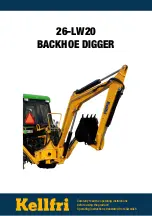
INTRODUCTION
Using implements and agricultural machinery
1. Do not connect implements or machinery that require more power than can be generated by your tractor model.
2. Never negotiate sharp turns with the power take-off under a heavy load; this may damage the universal joints on
the transmission shaft connected to the power take-off.
3. Never stand between the reversing tractor and the implement when hitching.
4. When using implements that require the tractor to be stationary with the engine running, keep the shuttle lever in
the neutral position, apply the hand brake and use suitable wheel chocks.
5. Do not operate tractors connected to the power take-off without first ensuring that the operating range of the tractor
is free of bystanders. Also check that all rotating parts connected to the power take-off shaft are correctly protected.
6. Add some type of rear ballast when using lifting equipment fitted to the front of the tractor. Rear ballast, such as,
rear wheel weights, fluid in rear tires or three-point weight box.
Fire and explosion prevention
Fuel or oil leaked or spilled on hot surfaces or electrical components can cause a fire.
Crop materials, trash, debris, bird nests, or flammable material can ignite on hot surfaces.
Always have a fire extinguisher on or near the tractor.
Make sure the fire extinguisher(s) is maintained and serviced according to the manufacturer’s instructions.
At least once each day and at the end of the day remove all trash and debris from the tractor especially around
hot components such as engine, transmission, exhaust, battery, etc. More frequent cleaning of your tractor may be
necessary depending on the operating environment and conditions.
At least once each day, remove debris accumulation around moving components such as bearings, pulleys, belts,
gears, cleaning fan, etc. More frequent cleaning of your tractor may be necessary depending on the operating envi-
ronment and conditions.
Inspect the electrical system for loose connections or frayed insulation. Repair or replace loose or damaged parts.
Do not store oily rags or other flammable material on the tractor.
Do not weld or flame cut any items that contain flammable material. Clean items thoroughly with non-flammable
solvents before welding or flame-cutting.
Do not expose the tractor to flames, burning brush, or explosives.
Promptly investigate any unusual smells or odors that may occur during operation of the tractor.
General battery safety
Always wear eye protection when working with batteries.
Do not create sparks or have open flame near battery.
Ventilate when charging or using in an enclosed area.
Disconnect negative (-) first and reconnect negative (-) last.
When welding on the tractor, disconnect both terminals of the battery.
Do not weld, grind, or smoke near a battery.
When using auxiliary batteries or connecting jumper cables to start the engine, use the procedure shown in the oper-
ator’s manual. Do not short across terminals.
Follow manufacturer’s instructions when storing and handling batteries.
48144025 23/06/2017
13
















































